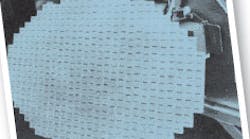Multimode radar systems have grown extremely sophisticated with advances in RF and digital signal processing (DSP). These systems have been in operation since the late 1970s, although in more basic form. In the May 1977 News section, MicroWaves charted the flight tests of the first multimode F-16 radar. It boasted more operating modes than previous airborne fighter radars of its kind. Among them were the now-common high-resolution synthetic-aperture-radar (SAR) systems capable of mapping, ground-target tracking, and terrain tracking/avoidance.
The first full-scale development radar for the US Air Force F-16 multi-role air-combat fighter was delivered to General Dynamics Corp. by Westinghouse Electric Corp., Defense and Electronic Systems Center (Baltimore, MD) in the spring of 1977 (Photo 1). It promised to provide extensive air-to-air capabilities for aerial combat, as well as air-to-surface capabilities for weapon delivery and navigation under adverse weather conditions. For example, the radar offered an "air-to-air downlink mode," which could distinguish low-flying aircraft from ground clutter. To get an all-weather picture of the ground area ahead of the aircraft, a "real-beam mapping mode" was included.
That spring also witnessed the first optical communication installation. Bell System officials chose Chicago for the site of the first commercial test under actual operating conditions. The optical fibers linked voice, data, and video signals between the Brunswick office building in the Chicago loop and the Franklin central office of Illinois Bell, which was about half a mile away. A second optical link stretched between the Franklin office and a second central office one mile away.
At the heart of this system was a 0.5-in.-diameter cable that was packed with 24 optical fibers (Photo 2). The multimode lightguides comprised low-loss silica glass containing controlled amounts of other oxides. They worked with either laser or light-emitting-diode (LED) light sources. At the time, Bell planners were most optimistic about a 1-mW, gallium-aluminum-arsenide (GaAlAs) laser operating at a wavelength of 0.82 . The optical transmission line, which would be buried under Chicago's streets, only introduced insertion loss of roughly 10 dB/mile. As a result, the planners didn't expect repeaters to be required for the two links. Standard modulation was 44.7 Mb/s.
In addition to voice and data, the installation supported Bell's long-awaited Picturephone servicealthough those transmissions required a dedicated pair of lightguides. Despite years of hype, Picturephone never quite did take off, owing to the equipment's size and expense. Its picture also was deemed too small to warrant the investment.
In 1977, Chicago also was the site of the "new concept" of cellular land-mobile radio. The FCC approved an application, filed by Illinois Bell Telephone (IBT), to construct and operate such a system at 800 MHz. The commission first denied a similar request. It then approved it, but only with the addition of a plan for monitoring the system's development. Only 10 base-station cell sites and as many as 135 mobile units could be used during the evaluation. The system used eight-mile-wide cells and tested two of the 10 cells for frequency reuse at a distance of roughly 48 miles.
Along with the first "Star Wars" movie, the incorporation of Apple, the lingering of disco, and the birth of punk rock, the late '70s marked the start of many technologies and applications that still bear fruit for the microwave industry. Those initial cellular experiments, optical-communications rollouts, and novel radar implementations paved the way for many of today's products, technologies, and services. Ironically, Bell's Picturephone didn't make it. But images are now sent by telephone over cellular networks and consumers are more than willing to adopt new communications technologies.


